Clear Your Hips for a Powerful Golf Swing
Know How to Clear Your Hips in Your Golf Swing? Discover Greater Flexibility and Powerful Speed with These Tips.
Do you know how to clear your hips in your golf swing? Do you feel like you understand what it means to clear your hips? Did you even know this was something you were supposed to do?
The best golfers understand how to clear their hips. But a lot of amateur golfers struggle with this concept. Not only do they have a hard time mastering the physical motion, but they don’t entirely understand what “clearing your hips” means.
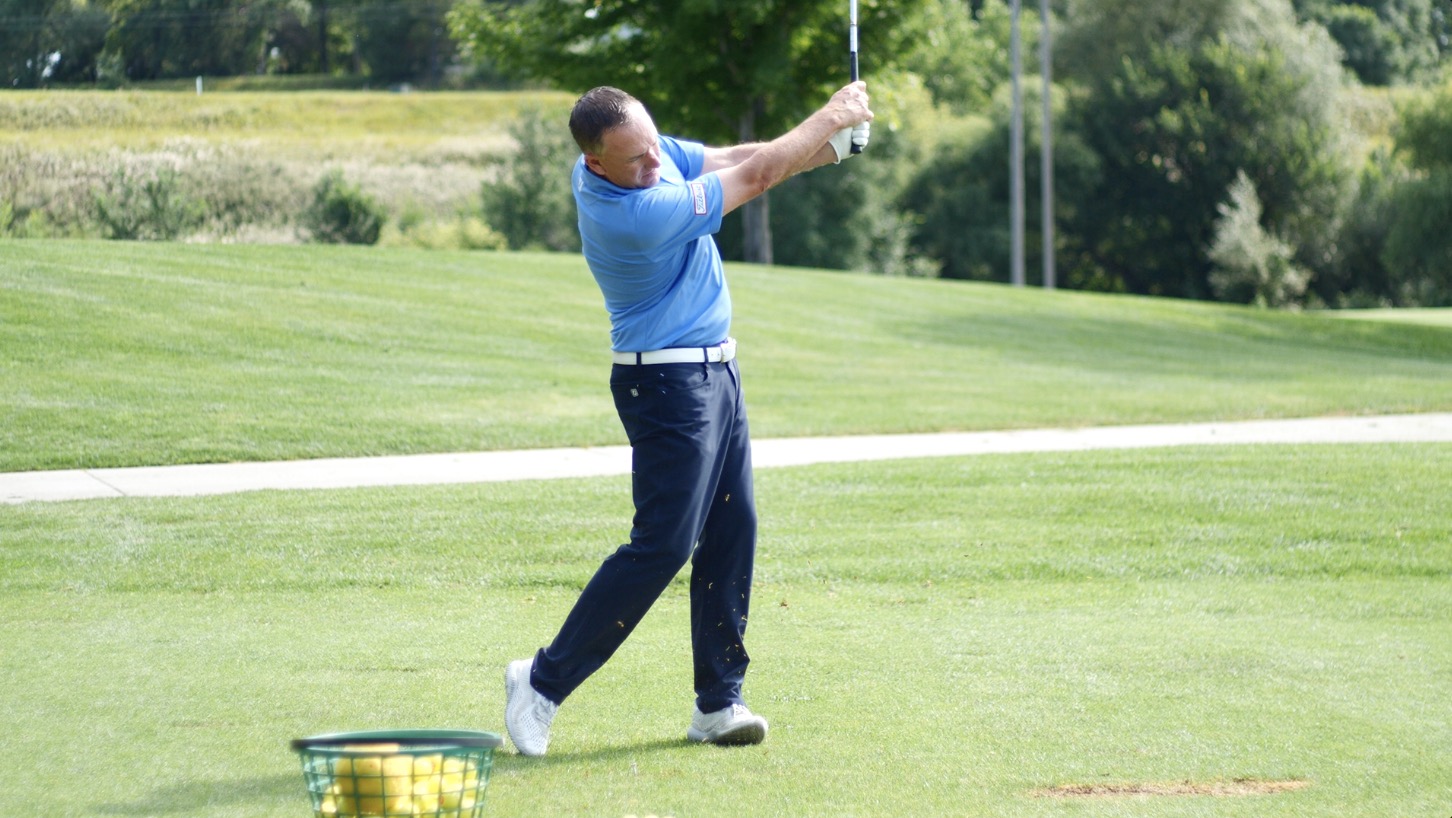
If you can clear your hips, you can hit higher quality shots and pick up a lot of clubhead speed. In other words, mastering this skill is more than worth it. It’s also easier than many casual golfers realize. You simply have to understand why clearing your hips matters, what holds you back, and how you can finally perfect this motion.
And you can find all those answers right here.
What Does “Clearing Your Hips” Mean?
First, let’s clarify what people are talking about when they tell you to clear your hips.
When you “clear your hips,” it means your hips are open towards the target at impact. Here’s what that looks like:
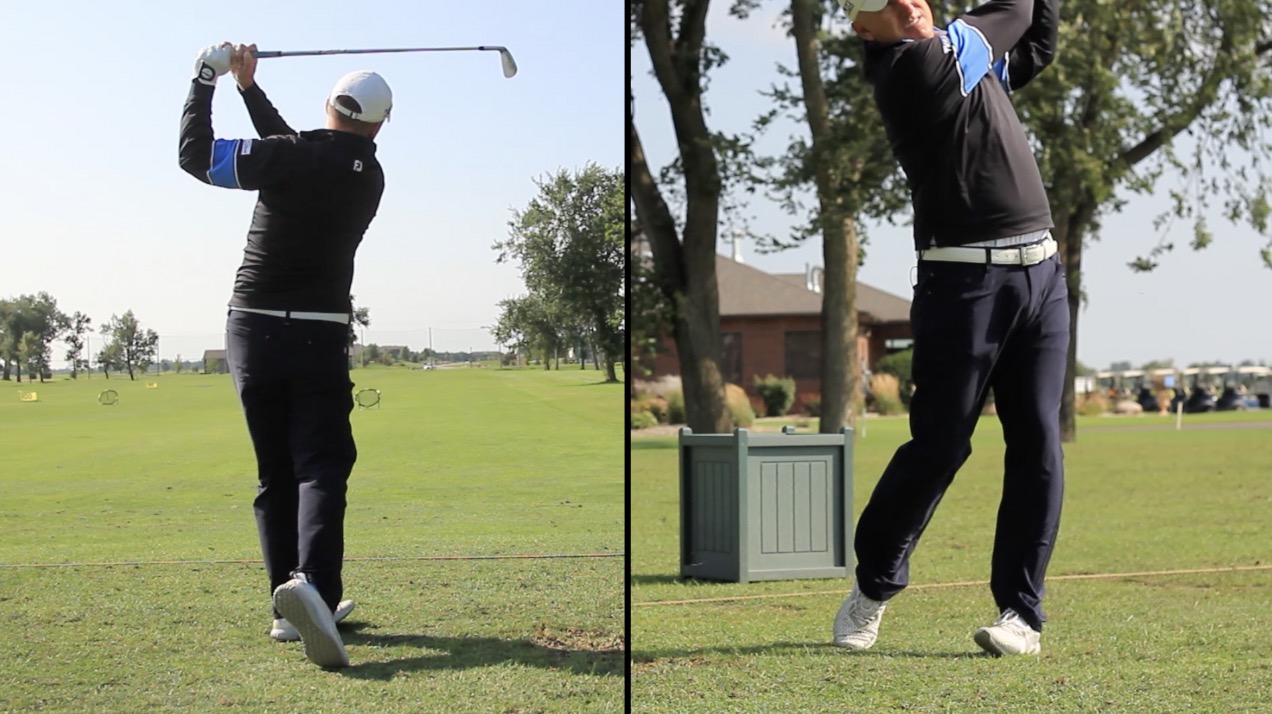
When you take your golf setup, your hips are square to the target. That is to say, the line across your hips aligns with the target. As you swing through, you want your hips to rotate so they are pointed to the left of the target at impact (if you’re right-handed). This is what we mean by “opening the hips.”
Clearing your hips is simply about rotating early in the golf swing and getting your hips out of the way. And the benefits of this are huge.
How Important is Clearing Your Hips in Golf?
For one thing, hip rotation helps you improve the quality of your contact. When you increase hip mobility, you find it’s easier to make square, solid contact with the golf ball.
But the major benefit of clearing your hips is that this motion is a huge speed generator. I mentioned previously that you can see this skill at work in the best golfers’ golf swings. If you watch the longest drivers in the game, you’ll notice those players have really fast hips.

Why?
Because rotation creates speed. A really great golf swing isn’t just about what your hand and arms are doing. It also has nothing to do with having big and a ton of strength. It’s a chain of movement in which one motion has the ability to either enhance or inhibit the next. Rotation in your hips facilitates rotation in your torso, which in turn helps you pick up speed in your golf swing.
Now, there are other benefits to clearing your hips beyond speed and contact. But I’m not going to dive too deep into that for this article. Just know that when you clear your hips, you drastically improve your game.
So, let’s talk about how you can improve flexibility, unlock hip flexors, and clear your hips with a simple adjustment to your lead foot.
Tips for Rotating Your Hips with Your Golf Swing
Before I get into drills and tips for improving your hip rotation on the golf course, I’d like to clarify why you’re having trouble with this skill. Clearing your hips is about more than mastering swing plane and swing motion. It’s about creating a swing that is both powerful and safe.
For many golfers, it’s not just lack of understanding that keeps them from clearing their hips. It’s limitations within their own bodies. Your first step in conquering this skill is to understand what’s holding you back and how you can overcome it.
Why It Might Be Difficult to Clear Your Hips
Hip rotation is a dynamic movement. This means it is hard to monitor and adjust in the moment. It also means your ability to improve hip rotation may be limited by two significant factors.
First, your own genetics might hold you back. Clearing your hips comes down to flexibility. And flexibility is like jumping. Some people jump higher than others simply because they are naturally better at it. I, for one, cannot dunk a basketball. And though I’ve seen plenty of other people do it, I don’t expect it will ever be talent I pick up.
Second—and more important for the purposes of this article—you’re probably wrestling with some tightness in the body. Maybe there’s tightness in your hip flexors, in your lower back, or in your body in general.
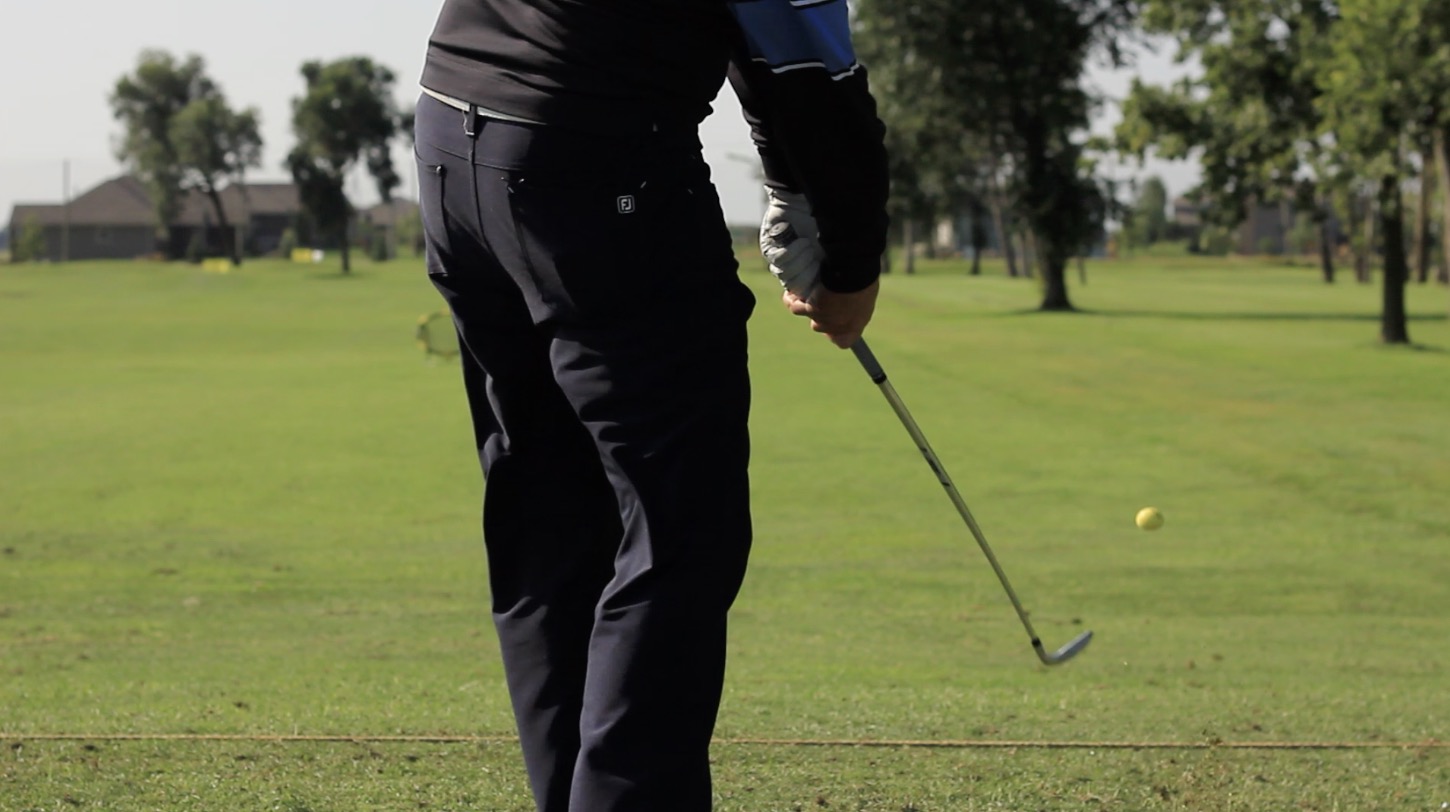
While golfers of any age can find themselves battling this stiffness, it’s especially common among older golfers. Our bodies lose flexibility as we age. While there’s no getting around that reality, there are steps we can take toward improving mobility. And when we take these steps, we not only hit better shots, but we also do more to protect the back.
Improving Mobility in Your Golf Swing
Does your back often hurt after a round of golf? Believe it or not, back pain is a problem that often originates from poor hip rotation. Now, failure to clear your hips is not the only possible reason for lower back pain, but it is a common one. If you don’t have good hip and upper body rotation, the lower back strains itself to pick up the slack.
So how do you fix it?
In a moment, I’ll get into some tips to help you practice clearing your hips during your golf swing. But one thing you can start doing right now in your own home is work on improving your hip flexibility. Matt Rollag, physical therapist at the Sanford POWER Golf Academy, recommends trying the 90/90 position.
The 90/90 position is a simple exercise that tests your hip mobility. You sit on the ground with each leg out in a different direction, both knees bent at a 90-degree angle. Just sitting in this position tells you a lot about your hip flexibility. If you have a lot of stiffness, you’ll topple over when you raise your arms out in front of you.
To challenge yourself and build flexibility, try shifting your legs from one side to the other. For example, if you’re sitting with the right side of both knees touching the ground, lift your knees and arc them over to the left side, without picking your feet up or using your hands to stabilize yourself. This simple exercise helps you test and enhance mobility so you can enjoy a better golf game.
Now let’s talk about changes you can make on the golf course.
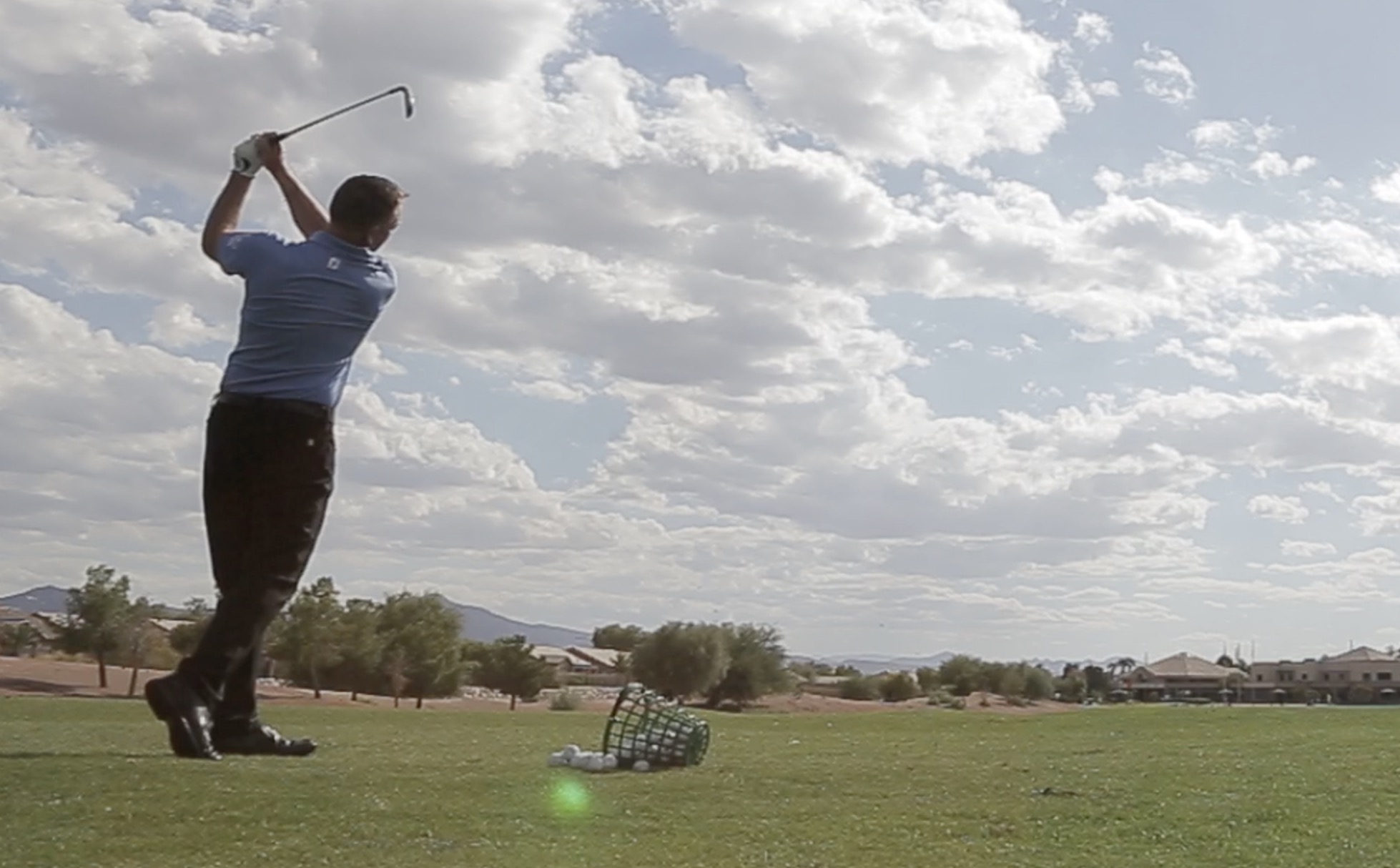
How to Open Your Hips When You Make Impact
As I mentioned, clearing your hips simply means opening your hips at impact. There are a couple different drills you can practice to help you develop this habit. But there are also small changes you can make on the golf course today that will help you clear your hips.
Both these changes happen in your golf setup.
First, set up your golf shot as you normally would, with an athletic stance, good posture and slight bend in the knee. Most likely, your toes are both pointed straight ahead in the direction of your golf ball. From this position, you’re going to make two adjustments to your lead foot.
- Point the left toe out slightly—somewhere between 30 and 45 degrees if you’re a right-handed golfer. We call this “opening your stance.”
- Pull the lead foot back just a little so it’s on a plane just slightly behind the trail foot.
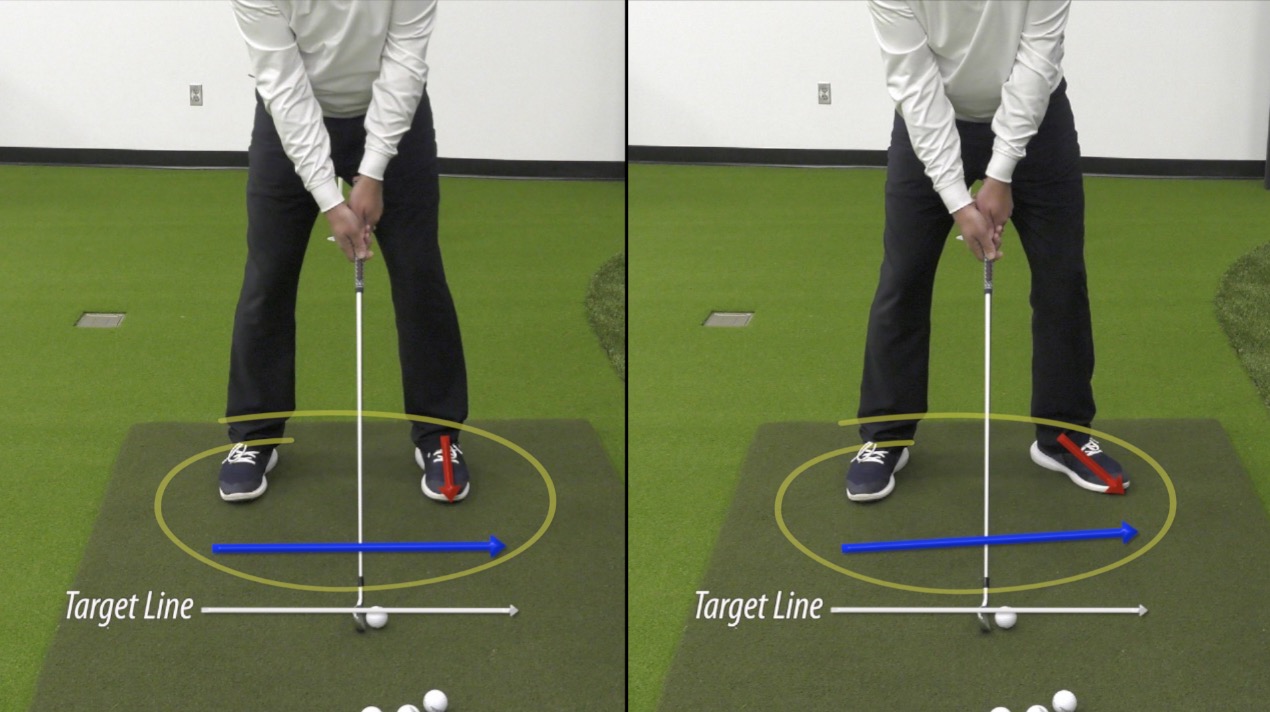
Both of these adjustments loosen your stance so you have more space to get better rotation in the hips and pelvis.
Consider it this way: If your lead foot (left foot for right-handed golfers) points straight ahead, that ankle is going to get stuck and lock you down at impact. You won’t be able to get the rotation you need through the lead/left leg and in the hips.
You have an even worse problem if you close your stance. Closing your stance means your trail foot points out to the right (if you’re right-handed). Opening your hips from this position takes a lot of flexibility . . . and a lot of work.
Exercises like the 90/90 position can do a lot to improve your golf fitness and give you better hip mobility. But it’s also a good idea to give yourself a leg up (and help your learn to use this new range of motion) with a smart golf setup from the beginning. Point that lead foot, pull it back, and enjoy immediate improvement in your golf swing.
Techniques to Clear Your Hips in Your Golf Swing
The previous advice helps you clear your hips by setting you up for success. You’ve learned how to improve flexibility and how to adjust your stance to make hip rotation easier.
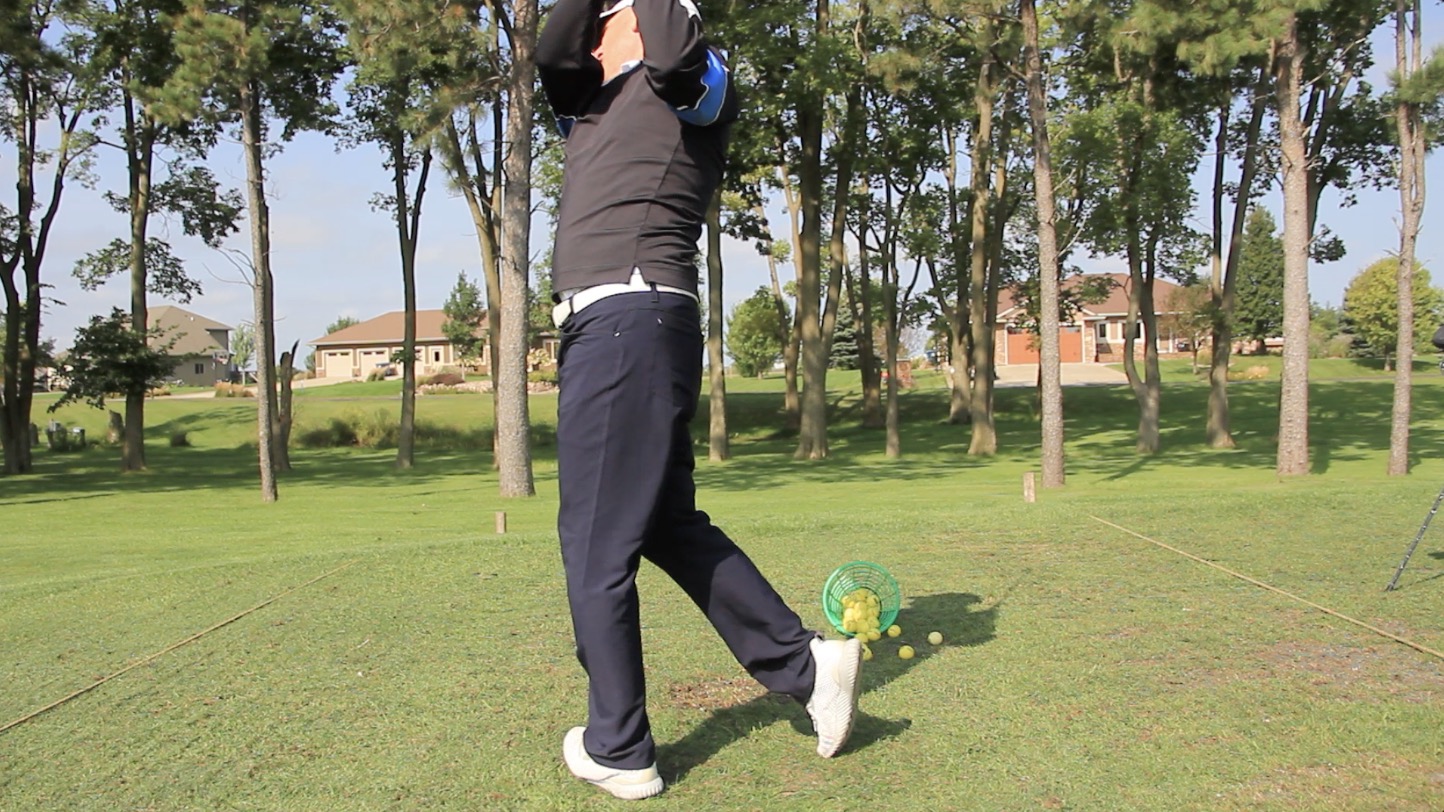
The last thing to do is learn what he proper hip rotation actually feels like so you can make it happen every single time.
Use the following two drills to practice clearing your hips at the driving range or even at home. You’ve probably already done plenty of drills on swing plane. These exercises help you focus on hip plane—the path your hips follow through the backswing and the moment of impact.
Hip Rotation Drill #1
For this drill, you need an alignment rod. That’s it. You can involve your golf club and golf ball if you want to, but it isn’t really necessary.
To get set up, take the alignment rod and hold it lengthwise across your hips. Some golfers like to actually thread it through their belt loops. Either way works.
Once you’re set up:
- Rotate your body to mimic your typical swing motion from the takeaway to the finish.
- As you do this, practice getting the trail end of the rod pointing down at your ball by the moment of impact.
- Repeat this motion several times.
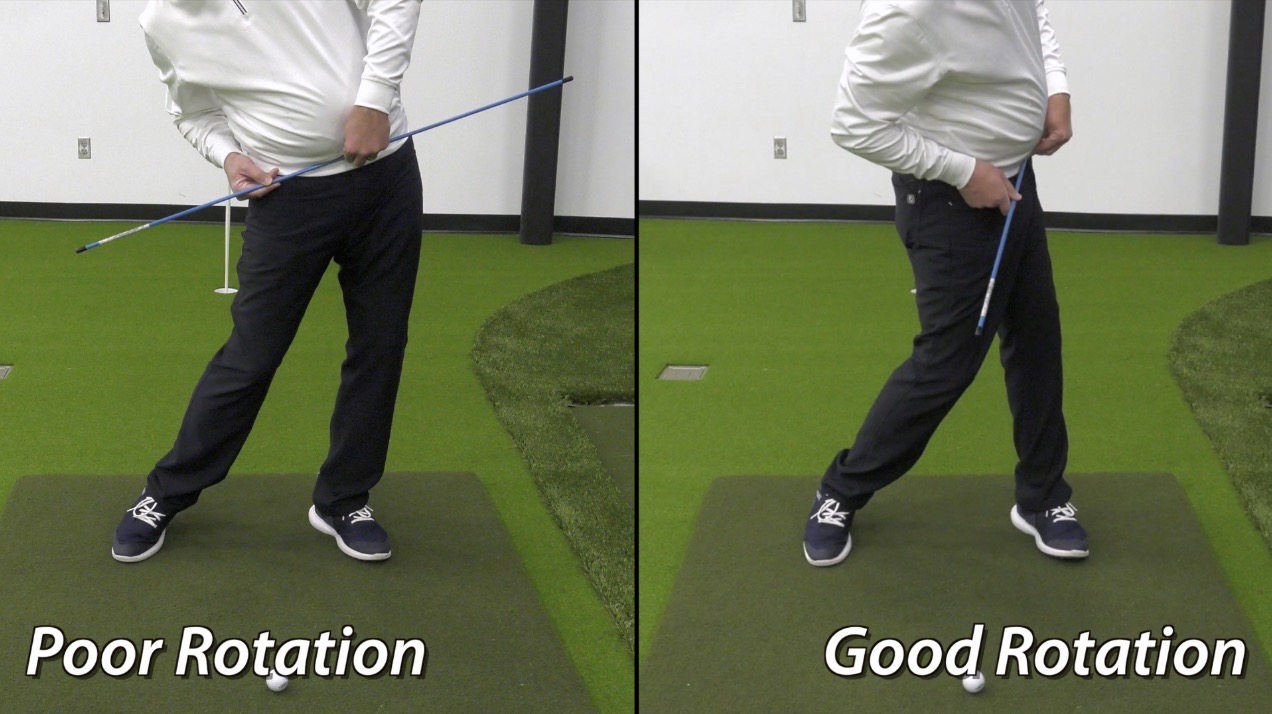
One thing I love about this drill is that it provides a clear and immediate visual of your current hip rotation. If the alignment rod traces a more vertical path and stays behind the ball—suggesting a lateral pelvic tilt—you know you’re not opening your hips.
There are also a lot of ways to adapt this drill for your needs. Some golfers like to use a shorter rod and position it in their belt loops so they can actually hit the ball while they practice. If this is how you prefer to do it, be careful with your hands and arms. It’s very easy to hit the alignment rod and injure yourself.
Hip Rotation Drill #2
You actually will hit the ball for this drill. You’ll also need a training aid similar to the Swing Arc by The Perfect Putter. This aid is basically an arced alignment rod. That curved shape makes it the perfect visual to understand the path of your hips.
Here’s how you can use the Swing Arc to clear your hips.
- Take your golf setup.
- Position the Swing Arc on the ground between yourself and the ball. One end of rod should be about where the ball is, with the rest of the rod curving out to the left of the target line (if you’re right-handed).
- Take your golf shot, careful to follow the curve of the Swing Arc with your hips.
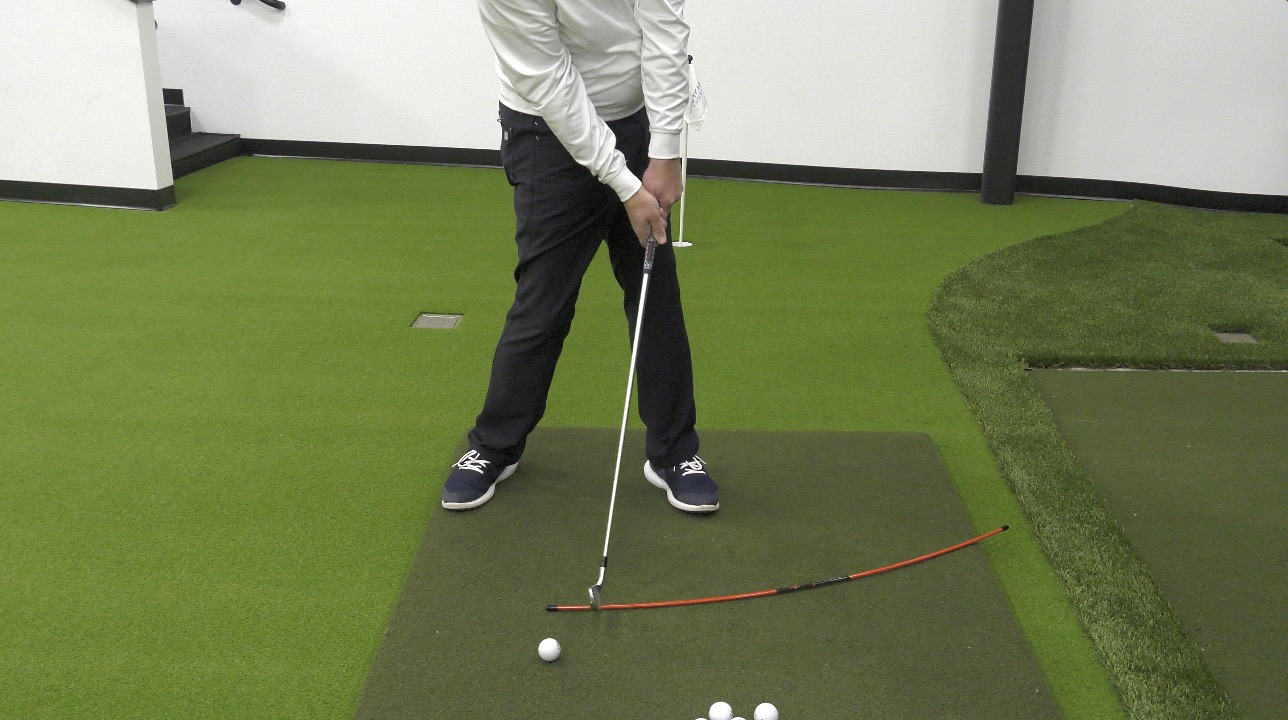
I love this drill because it provides a crystal clear visual for your hip path. With enough practice, you can train your body to understand what it feels like to clear your hips. Then, you can consistently open your hips at impact for every single shot you take.
To put it another way, you can start cranking up that clubhead speed and launching the ball farther than you thought possible.
Quick Recap
Any Questions About How to Clear Your Hips?
Did you find this advice useful? Join us in the comments and let us know what you thought. We’d love to hear if these tips worked for you, answer any additional questions, or discuss any difference of opinion.
For more in-depth golf tips, visit us at GreatGolfTipsNow.com. This new video series is completely free and packed with detailed advice to help you play better golf!


I agree 100% – For me when using my driver and I find myself mishitting or poorly hitting the ball 99% of the time I find my hip movement has stopped almost entirely so I end up compensating with my upper body and arms.
Thanks for reading and commenting Mark! Which tip did you find to be most helpful?
Instead of worrying about how to rotate the hips out of the way, which can lead to all sorts of problems including back issues, when you get to the top of the swing, with your weight roughly about 50/50 on each foot, just think about straightening your left leg. Don’t think about anything else. Just straighten your lead leg and don’t worry about the arms or hips or shoulders. When you let the swing happen, the arms just wrap around your body and you just stand there watching this beautiful ball flight and you realize that it was effortless.
Any drill to improve the timing of the start of the hip turn with the backswing/downswing? Have read previously that the hip turn starts before completing the backswing — not all that easy. And, any comment on the recommended speed of the two (backswing and hip turn) when getting them sync’ed would be helpful.
Do you have any advice on how to make hip rotation an habitual part of your swing when you don’t come by it naturally?
Good question Dick! The hips are a key driver of the golf swing and moving them in the correct way is imperative to hitting solid shots. We just did a video on increasing mobility: https://youtu.be/hM35rRenTwY
This will provide you with some guidance and direction…hope it helps! Thanks for asking!
I really like your videos Todd, you do a great job explaining the key points and provide great simple drills. I wish you were closer to Mass. I’d like to take some private lessons and go on the course with you for a round. Keep doing what you’re doing!
The best lesson I’ve ever taken (read) on the proper opening of hips.
Could you send pictures of the exercises. Thanks Bill
A few days ago, I saw the video to place my left arm on top of my chest to stay connected. I have really hit the ball very solid the past few days. Some days when I clear my hips, I will either hit a toe shot or a pull hook. Any advice to correct that. I assume that I am coming up out of the shot for the toe shot??? Not sure what to do about the pull. Love the video tips. Thanks.
I have video of my son a year ago at impact with pga hips, meaning they are wide open. Now he can’t do it and continually early extends. I get behind him and work his knees and can get his hips to open on slow mo video but once I leave him alone his trail foot rises and his hips go to the ball. I like both drills and the setup adjustments actually got us both bombing our drivers farther on the range yesterday. Do you have another drill to keep the right foot more grounded through impact? I’ve been watching your videos for years, thanks for all the tips.
Henry, this is a great question. Let me visit with our team and do a video on this question in the near future. We will report back…thanks for your support and the idea!
Awesome news on the improved contact with the lead arm on the chest idea…it is a good one! One of the keys to good contact is good tempo, here is a great drill we did for that which will help https://youtu.be/El0UZEXqxhU
Bill, what pictures would u like to see? Thanks!
Wow…awesome! Thank you for the nice comments…our team does its best to provide good solid information for our fellow golfers…more great content to come!
Our pleasure Steve! We need to make a road trip to Mass 😉
Jim, solid question. The key is tempo and timing…getting things in the right order. Take a look at this video as it will help https://youtu.be/El0UZEXqxhU
Dave, some good points made here…thanks for adding to the conversation!
Todd,
About your tip opening your hips. I’m a senior golfer and your tip about turning more has helped. Now how is putting my right foot back a little to get more turn-taking the club back which is great for me. Now watching the video it looks like you are turning your left foot out and back. now on the video showing more turn, I have turned my left foot out already, and if I put it back I’m back to where I started. So how can I get my hips out of the way?
Bob, great questions. Glad to hear you are finding the information helpful!! We like to see our students have their toes pointed out around 20-25 degrees. This promotes more turn/pivot and is easier on the back. Does that help?
Todd, First ever explanation of “clearing hips”. Thank you. Question: How do shoulders sync with hips? I try to keep my shoulders square or slightly closed at impact. Right? This lesson implies that the hips and shoulders separate by degrees and timing at impact. If I reach impact with open shoulders, then there goes my draw? Enter Push or slice? Appreciate some clarification. Love your instructions and techniques! Thanks, Bob
Todd, I am 79 and have all the “experienced golfer” ailments you are currently addressing. Many years ago Lee Trevino offered a tip that is helping me and may address Bob Kuhn’s concern. Lee recommended placing both toes pointing outward about 30deg and assuming a bow legged position as you bend to posture. Now, rotating back and through from here is much easier on my lower back. Try it.
Hi Todd:
I found your article/video very interesting. Your explanation and drills were excellent, your setup instructions were right on the money. I have no problem with your article/video, However, by positioning your left foot (right hand golfers) back of your right foot leaves you in an OPEN position at address, which for many armatures including myself could leave your upper body (shoulders, arms and club) OPEN to your target line leading to a over the top move. To avoid an over the top move you MUST leave your BACK facing the target when starting your transition. This Back to the Target has been touted by many professional instructors for years as a way to eliminate Over the Top Move. As for myself I use a lot of hip turn while briefly holding my back facing the target. I’ve checked myself on video and I’m right on PLANE . I’m fortunately to have a golf cage in my home that I setup last year using SKY Track and Swing Catalyst software. I sincerely hope my input helps other golfers.
FYI…..I’m 82 years young and shoot to a 9 handicap.
This is a solid post with many great points. You are correct that an open stance can cause an “over the top” move in the transition if not careful. Thanks for sharing! Have you watch our Vertical Line Swing videos? https://youtu.be/4obK1N-N9qY
Steve,
Thanks for adding to the conversation! Lee Trevino is an all time great, one of the best ball strikers of all time!
Bob,
Good questions. Ideally we want the hips slightly more open at impact than the shoulders. However, this should happen naturally if possible. If the shoulders open too early, this can and may cause a slice. Here is a good video to help https://youtu.be/dx-H4ntMcGs
great tips Todd, will try out next round. Am only scared that an open stance may not lead to a fade with the resultant loss in distance ? I am an accomplished fader of the ball, but zero at Drawing.
Fair point and valid concern. The key is to make sure the clubface is square at address and square going back. Here is a great video on the topic https://youtu.be/Z8LyPGy8Ycc
This is a good intro to hip movement in the golf swing but a lot of traps still remain for the average golfer when taking your advice to the range or the course. I’m talking about other problems that often crop up, like spinning the hips and getting the club stuck behind you. These just as serious and just as common problems can stem from too much hip rotation and are just as bad as insufficient hip turn because they lead to compensations like early extension, swinging over-the-top or casting. After long study, I have learned that there are a few additional tricks to clearing the hips in the proper way. You need to maintain proper tilt and keep your head back as you clear the hips by turning the right hip back in the backswing and leaving it back as the downswing starts. This avoids the mistake of driving the right hip out and/or laterally forward to the target in the downswing. Instead, of over-rotating the right hip, you should continue pushing the left hip around, back and away from the target. You get lots of hip turn from your left side doing this, while the right hip remains passive. If I had to describe it in terms of an image, the right hip would be like the stationary, hinged side of a door (albeit a tilted door) and the left hip is the swinging part of the door that hangs on the hinge. Think of it as the lead side being a normally opening and closing door, instead of a revolving door where everything (in this case both hips) rotates around a centre. This stuff works for me, anyways
Thanks for the tips. It seems the movement of the hips is often left out of instruction. Starting with the lower body first is probably the hardest part. Doing everything you said with not immediately also rotating the upper body definitely allows the club to drop more from the inside. Shifting the weight and posting the left hip up and back before striking the ball also keeps the spine angle down nicely. Automatically puts everything into place.
Thank you from Vancouver, BC. I have yet to try flaring my lead foot, left and back a bit on the golf course but just at home this address feels right, not ‘handcuffed’. I have just turned 75, am in good shape but my golfing buddies consistently out distance all of my shots so I am grateful for this advise. Thank you!
Wayne
TO ALL LOWER BACK PAIN SUFFERERS…………….
I’m an amateur golfer with a natural fast swing speed of 112mph and lower back problems. I find that when I open my stance and flare my left foot it makes my back feel worse and unprotected so I usually bail out and go over the top to protect my back and bad things happen.
I keep most of my weight on my left (ball of) foot and find that if I flare my left foot it restricts my kneecap from fully turning. If I keep my left foot pointed forward and rotate my left knee better it allows me to open my stance behind me to create a more controlled and free backswing.
I keep all iron ball positions to right of sternum and woods to left of sternum and generally strike it well with ball then turf in a slight draw.
Haven’t got much off a follow through but I find this helps my back and stops me crawling up the 18th fairway.